Infographic Available*
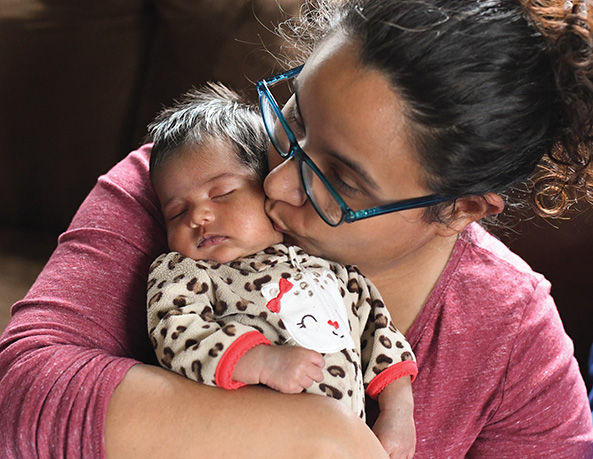
مرحبًا أيها العالم
أنا طفلك. وأنتِ كل شيء بالنسبة إليّ.
ساعديني على النمو لأتمتع بالقوة في جسدي وقلبي وعقلي. إنني أنمو بشكلٍ أفضل عندما:
- تحملينني ويكون هناك تلامس مباشر بين بشرتي وبشرتك أو تضمينني إلى صدرك، فأنا أشعر بالأمان وأنا بين ذراعيك.
- تبتسمين لي وتتحدثين إليّ، فأنا أتعلم الكثير منكِ.
- تستمعين إليَّ عندما "أتحدث" إليكِ، فأنا أستخدم حركات جسدي وأصدر أصواتًا عندما أكون جائعًا، أو شبعانًا، أو غير مرتاح، أو متعبًا فحسب.
حليب الأم أو حليب الأطفال الصناعي الغني بعنصر الحديد هو كل ما أحتاج إليه للنمو والتطور خلال الأشهر الستة الأولى.

الرضاعة الطبيعية
لديكِ ما أحتاج إليه لأنمو.
يعد حليب الأم الغذاء المثالي بالنسبة إليّ.
- إنه يحتوي على جميع العناصر الغذائية التي أحتاج إليها لمساعدتي على الحفاظ على صحتي وعدم الإصابة بالمرض.
- كلما كبرت، يتغير حليب الأم الذي أحصل عليه. وكلما طالت فترة الرضاعة الطبيعية، كان ذلك أفضل لي.
إذا كنتِ تعتمدين فقط على الرضاعة الطبيعية، فاستشيري مقدم خدمات الرعاية الصحية واسأليه عما إذا كنتُ بحاجة إلى الحصول على المزيد من فيتامين “د”، واسأليه أيضًا عن إمكانية الحصول على مكمل غذائي غني بالحديد عندما أقارب بلوغ سن 6 أشهر.
التغذية على الحليب الصناعي
إذا كنتُ سأعتمد في غذائي على الحليب الصناعي، فمن المهم أن يتم خلط المكونات بالطريقة الصحيحة، من خلال اتباع تعليمات الخلط الموضحة على العلبة.
احرصي دائمًا على إضافة الماء إلى زجاجة الرضاعة أولاً، ثم مسحوق الحليب الصناعي.
استخدمي دائمًا المغرفة الموجودة في علبة الحليب الصناعي، وتأكدي من أن يكون مستوى مسحوق الحليب بها ممسوحًا.
قدِّمي إلى طفلك حليب الرضَّع الصناعي المعدّ في غضون ساعتين من تحضيره. وإذا لم تستخدميه في غضون ساعتين من تحضيره، فقومي بتخزينه في الثلاجة واستخدميه خلال 24 ساعة.
بمجرد أن أبدأ في الرضاعة، تخلصي من أي حليب صناعي متبقٍّ في الزجاجة بعد ساعة واحدة.
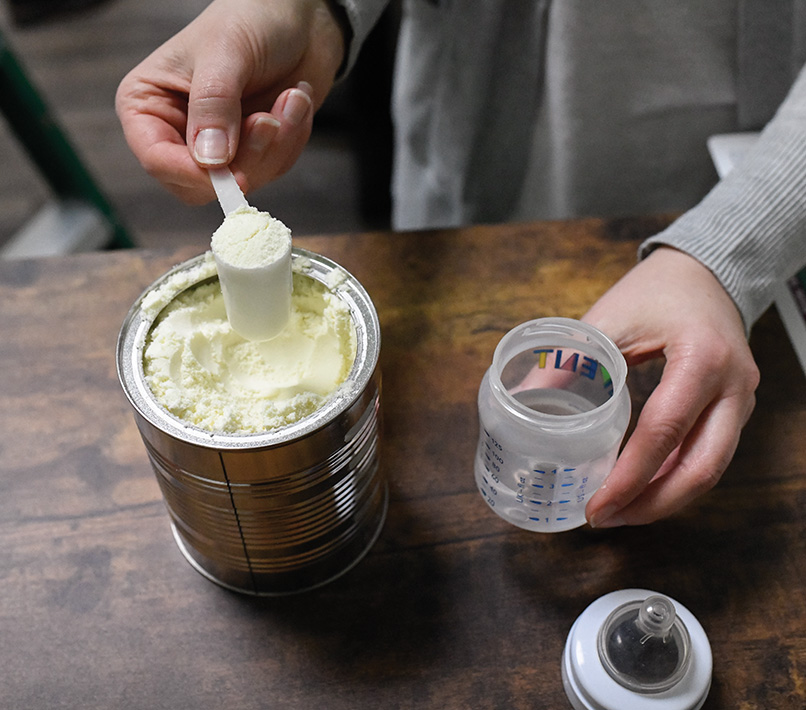

الإرضاع بالزجاجة بمعدل سرعة منتظم
- ابدئي بإرضاعي كمية صغيرة فقط في المرة الواحدة، أي 2 إلى 3 أونصات من حليب الأم أو الحليب الصناعي.
- دعيني أتحكم في مقدار سرعة شربي من الزجاجة.
- ثقي بي بأنني سأعلم متى أشعر بالشبع. لذا، من فضلكِ لا ترغميني على تناول كل محتويات الزجاجة.
- احتفظي بالزجاجات المعدّة في ثلاجة حتى تكوني مستعدة لإطعامي، واستخدميها في غضون 24 ساعة.
- تجنبي مطلقًا وضع حليب الأم أو الحليب الصناعي في الميكروويف، إذ قد تتسبب "البقع الساخنة" في حرق فمي. كم هذا مؤلم! بدلاً من ذلك، يمكنك تدفئة زجاجات الرضاعة في الماء الدافئ.
أحتاج إلى الشعور بلمستكِ
احمليني أثناء الرضاعة.
أنا أشعر بالأمان بصحبتك، وأحب النظر إلى وجهك.
في بعض الأحيان، قد أستريح من الرضاعة، مع أنني لم أشعر بالشبع بعد. فهذا يعني أنني أريد فقط أن أستريح، أو أن أتشارك معكِ بعض اللحظات الخاصة.
أحتاج إلى أن تُطعمِيني كثيرًا*
معدتي لا تزال صغيرة.
يمكن أن تستوعب معدتي حوالي 2 إلى 3 أونصات في المرة الواحدة.
سأحتاج إلى الرضاعة 8 إلى 12 مرة خلال 24 ساعة.
احرصي على إرضاعي كل ½1 إلى 3 ساعات.
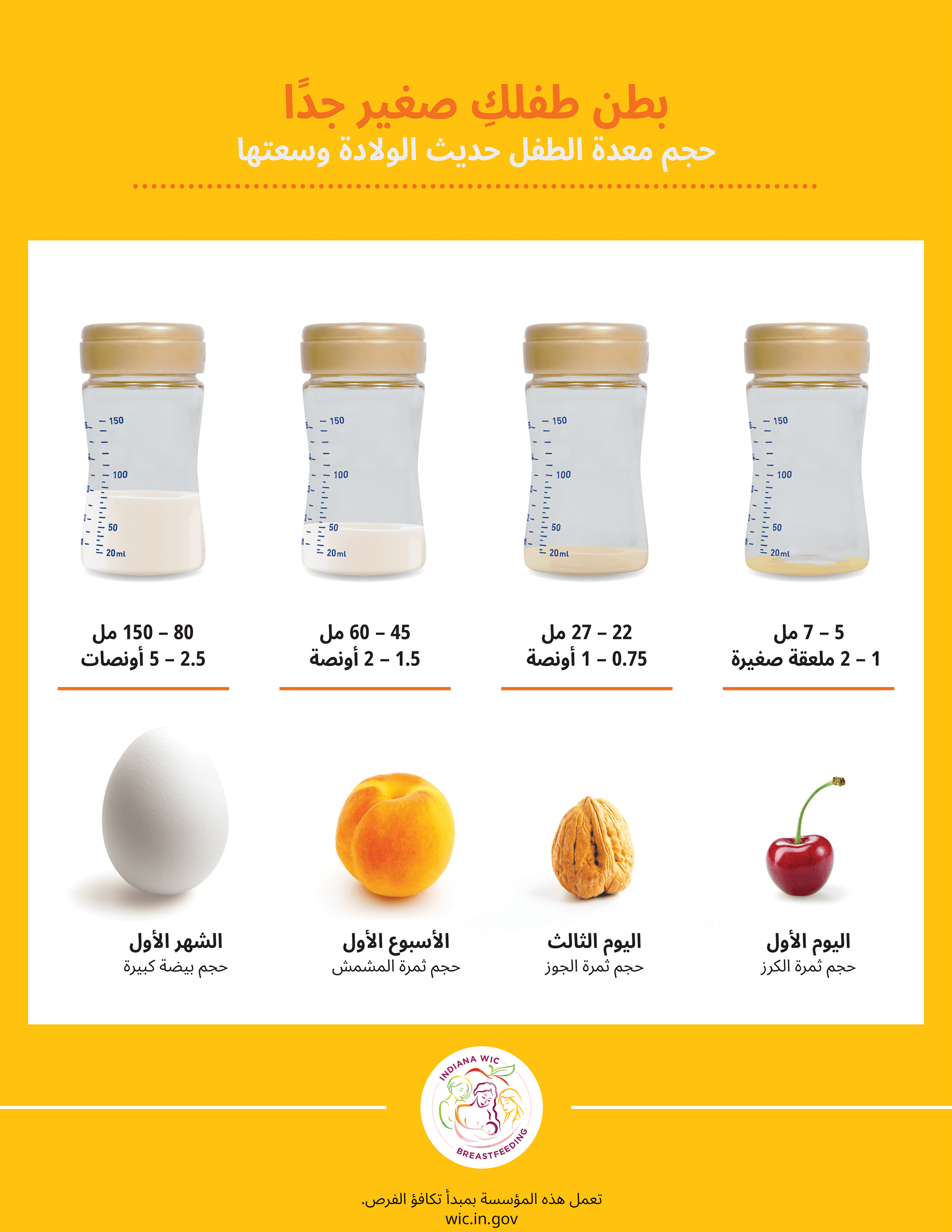

يمكن أن تستوعب معدتي حوالي 4 إلى 6 أونصات في المرة الواحدة.
سأحتاج إلى الرضاعة 6 إلى 8 مرات خلال 24 ساعة.
تذكَّري أن كل طفل مختلف عن غيره. قد تختلف كميات الحليب التي أتناولها من يومٍ لآخر. ومع تقدمي في السن ونمو حجم معدتي، قد تقل مرات الرضاعة، لكن يمكنني تناول كميات أكبر من الحليب في كل وجبة.
انتبهي إلى العلامات التي أصدرها
أنا أستخدم حركات جسدي وأصدر أصواتًا لأخبركِ بما أحتاج إليه. إذا راقبتِ هذه الإشارات، فستستطيعين الاستجابة لما أريده قبل أن أبدأ في البكاء. فمن السهل بكثير إطعامي عندما أكون هادئًا.
"أنا أشعر بالشبع"
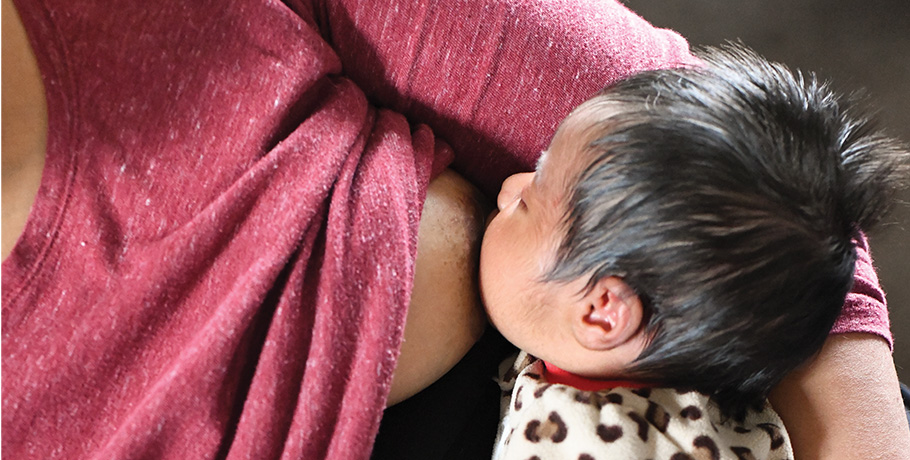
عندما أشعر بالشبع، قد أقوم بالإشارات الآتية:
- أرضع بوتيرة أبطأ أو أتوقف عن الرضاعة
- أُرخي يدي وذراعي
- أبتعد عن الحلمة
- أدفع الثدي أو زجاجة الرضاعة بعيدًا عني
- أغطّ في النوم
- يبدو على وجهي العبوس، أو أثير ضوضاء، أو أركل الثدي أو زجاجة الرضاعة إذا واصلتِ إرضاعي
"أنا جائع"
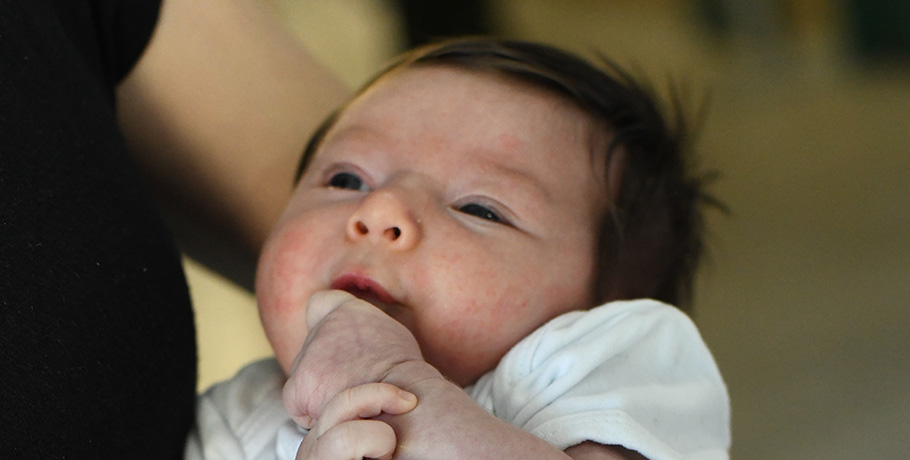
عندما أبدأ في الشعور بالجوع، قد أقوم بالإشارات الآتية:
- أضع يدي في فمي أو بالقرب منه
- أُحرك ذراعي ورجلي
- أُصدر أصوات مصّ
- أُحرك فمي أو لساني
- ألتفت برأسي، أو أبحث عن الحلمة
طفرات النمو
قد تتغير عاداتي كلما كبرت، وقد أرغب في الرضاعة والنوم أكثر من المعتاد. تُطلق على هذه التغييرات “طفرات النمو”.
يختلف كل طفل عن غيره، لكن تحدث طفرات النمو لديّ عندما أوشك أن أبلغ مراحل عمرية وفيها:

2 to 3 weeks

4 to 6 weeks

3 months

4 months

6 months

9 months
يعرف جسدكِ أيضًا بما أحتاج إليه، وسيعمل على إدرار المزيد من الحليب لمواكبة طفرات النمو تلك. وكلما زاد عدد مرات إرضاعك رضاعةَ طبيعية أو استخدام مضخة الثدي لسحب الحليب، زاد معدل إدرار جسمك للحليب.
إذا قمتُ بتصرفات تدل على أنني ما زلت جائعًا بعد الانتهاء من الرضاعة الطبيعية، فقدِّمي إليّ ثديك مرة أخرى. وإذا كنتُ أتناول وجبتي من زجاجة الرضاعة، فقدِّمي إليّ أونصة أو أونصتين أخريين.

Play with me!
I’m ready to learn about you, me, and the world we live in. I want to discover what my body can do. Give me TUMMY TIME when we play. When I’m alert and relaxed, put me on a blanket on the floor. Watch how I stretch and kick my legs and move my arms. I’m making them stronger.PLAYING helps me learn, improve coordination, build strength, explore, and bond with you!

العبي معي!

أنا على استعداد لمعرفة المزيد عنكِ، وعني وعن العالم الذي
نعيش فيه. وأريد أن أكتشف ما الذي يستطيع أن يفعله جسدي.
خصِّصي وقتًا أستلقي فيه على بطني أثناء اللعب معًا.
عندما أكون منتبهًا ومرتاحًا، ضعِيني على بطانية مفروشة على الأرض، وشاهدِيني وأنا أقوم بحركات التمدد وأركل بساقي وأحرك ذراعي. فهذه الحركات تجعلهما أقوى.
- يساعدني اللعب على التعلُّم، وتحسين مستوى التنسيق بين أعضاء جسدي وتقويتها، واستكشاف العالم من حولي، وتقوية الروابط بيني وبينك.
انظري ماذا يمكنني أن أفعل!
إنني أتعلَّم بشكل أفضل عندما أشعر بالسعادة والحب والأمان.
العالم جديدٌ بالنسبة إليّ. وقد يبدو مخيفًا. وقد أبكي كثيرًا في بادئ الأمر.
- البكاء هو طريقتي للتعبير عن حاجتي إليكِ.
- عندما يكون هناك تلامس مباشر بين بشرتي وبشرتك، يهدأ قلبي. وأعلم أنك تهتمين بي.
- لن يفسدني حملكِ إياي.
- في بادئ الأمر، ستجدين أن كل ما أفعله هو النوم والاستيقاظ والرضاعة، ثم العودة إلى النوم كثيرًا. وهذا الأمر طبيعي ويساعدني على النمو.
- بعد بلوغي سن 3 أشهر، قد أبدأ في النوم لفترات أطول.
- من فضلك تحلي بالصبر بينما أتعلم.
أعرف صوتك جيدًا.
- وأحب أن أسمعكِ تتحدثين.
- يمكنني النوم لفترة أطول في الليل.
- يمكنني رفع رأسي لأعلى.
- أعرف اسمي عندما تنادينني به.
- يمكنني أن أناغي وأقول “با-با-با”!
- يمكنني الضحك.
- لنلعب معًا لعبة “الغميضة” ولعبة “التصفيق بكفوف الأيدي”.
- أريني الصور وأخبريني ما الذي يوجد فيها.
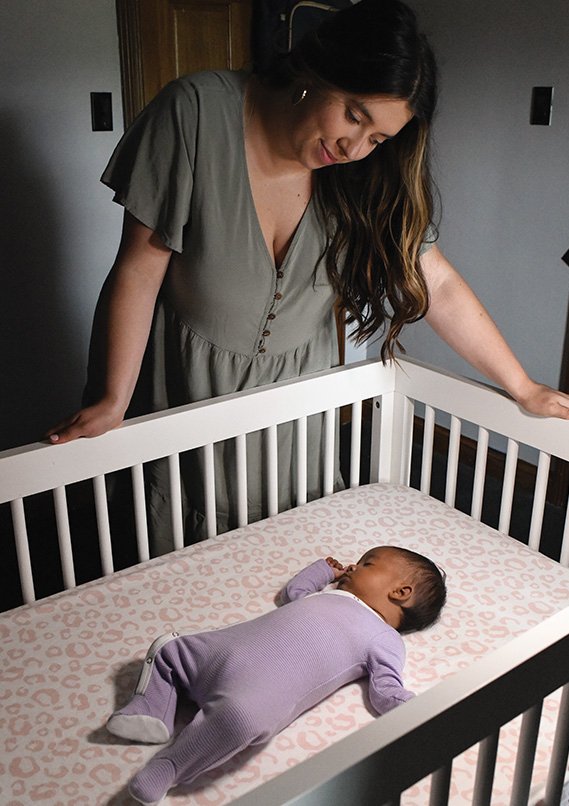
حافظي على سلامتي وصحتي
- احرصي دائمًا على أنام بمفردي مستلقيًا على ظهري، في سرير الأطفال الثابت أو سرير النوم واللعب المتنقل. ويمكننا أنا وأنتِ مشاركة غرفة واحدة، لكن ليس النوم على السرير نفسه. وقد أتعرض للاختناق إذا حركتُ بطانية أو وسادة أو لعبة لتغطي فمي أو أنفي.
- اغسلي يديكِ قبل إعداد الرضعات وإرضاعي.
- بعد الانتهاء من الرضاعة، امسحي لثتي بقطعة قماش نظيفة وناعمة ورطبة، خاصةً قبل النوم.
- لا تقدمي إليّ الأطعمة الصلبة حتى أبلغ 6 أشهر. أحتاج إلى الوقت حتى يتطور جهازي المناعي وتقوى عضلات فمي كي أستطيع أكل الأطعمة وابتلاعها بشكلٍ صحيح. وإذا تم تقديم الأطعمة الصلبة إليّ قبل أكون مستعدًّا لذلك، فقد أختنق أو أُصاب بالمرض.
- تجنَّبي تناول منتجات التبغ أو النيكوتين، والمشروبات الكحولية والماريجوانا، وغيرها من أشكال تعاطي المخدرات للحفاظ على صحة وسلامة أسرتنا. وللحصول على الدعم اللازم للإقلاع عن تناول منتجات التبغ أو النيكوتين، يمكنكِ زيارة الموقع الإلكتروني: www.quitnow.net. وللحصول على الدعم اللازم للإقلاع عن تناول المشروبات الكحولية أو المخدرات الأخرى، يمكنك زيارة الموقع الإلكتروني التالي: www.findtreatment.gov. يمكن أيضًا لاختصاصي التغذية التابع لـ Special Supplemental Nutrition Program for Women, Infants and Children (WIC، برنامج التغذية التكميلي الخاص للنساء والرضّع والأطفال) تزويدك بموارد إضافية.
DON’T let me have these foods until I am at least 1 year old:
Cow’s milk or other non-dairy milks (like soy or almond milk). It’s too hard for me to digest and may cause health problems.
Honey and foods made with honey. Honey can contain bacteria that cause infant botulism, or food poisoning. These bacteria are harmless to older kids and adults.
Introducing Peanut Butter
If my healthcare provider says it is ok, let me try peanut butter around 6 months of age. Doing this might help prevent a peanut allergy as I grow older.
In the morning, mix one teaspoon of peanut butter with human milk or formula. Make it thin and easy to swallow.
Use a spoon to offer a taste of the thinned product. Wait 10 minutes, then offer more. Watch for any reaction for the next 2 hours.
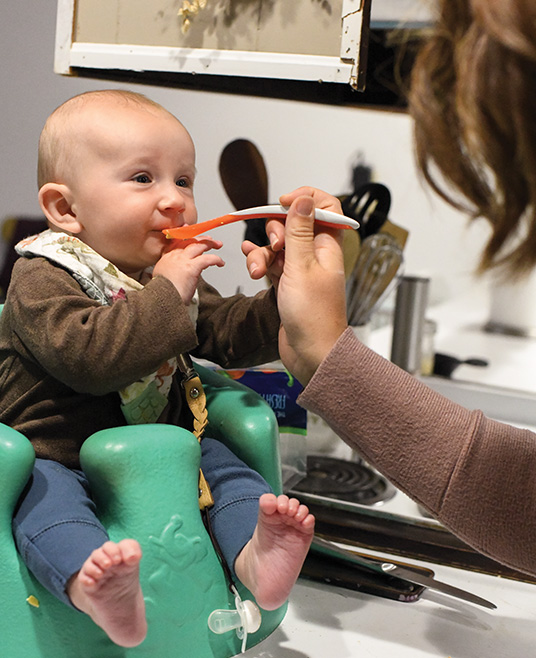
للحصول على الدعم بشأن الرضاعة الطبيعية، يمكنكِ الاتصال بإحدى استشاريات دعم الأقران حول الرضاعة الطبيعية في إطار برنامج WIC المحلي، أو الاتصال بخبير شؤون الرضاعة الطبيعية المعيَّن التابع لبرنامج WIC.
تعمل هذه المؤسسة بمبدأ تكافؤ الفرص.